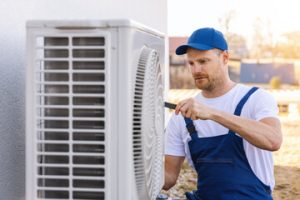HVAC systems provide heating, cooling, and ventilation. They can help keep indoor spaces livable in cold weather and protect equipment from damage caused by poor air circulation.

On average, HVAC systems last 15-20 years with regular maintenance. Learn how to determine the age of your unit by looking for a serial number or service data plate. Contact 24 Hour HVAC Company for professional help.
The basic function of HVAC systems is to warm homes and offices, but they do much more. They also clean the air and protect against harmful pollutants, allergens, and bacteria. Getting an in-depth understanding of the various parts of an HVAC system is key to ensuring optimal comfort all year round.
While the acronym HVAC might seem intimidating, there are ways to make sense of the technical terms and terminology. By breaking down the parts of an HVAC system, you can see how the system works and what role it plays in your home or office.
Heating is a vital part of the HVAC system because it keeps indoor spaces livable in cold climates. Furnaces, boilers, and heat pumps use electrical energy or natural gas to generate warmth and distribute it throughout a home or office through a network of ductwork. To avoid carbon monoxide leaks and other serious health hazards, it’s important to have your heating system serviced annually by a qualified technician.
Ventilation is another crucial aspect of an HVAC system, because it keeps the air in indoor spaces fresh and healthy. Ventilation uses a ductwork system to circulate filtered air, removing stale odors and reducing the presence of mold and mildew. It also removes excess moisture from the air, which helps prevent rot and other issues that can affect indoor spaces.
Cooling is the final aspect of an HVAC system that many people don’t think about, but it is essential to your comfort. Cooling systems use a refrigerant to change the temperature of air, and they can be powered by electricity or by gas. To achieve the highest possible cooling efficiency, it’s important to choose a model that has an ENERGY STAR rating.
An HVAC system also contains a number of electrical components, including wiring, batteries, fuses, and circuit breakers. It’s important to keep these electrical elements in good working condition, which is why it’s important to schedule yearly maintenance visits with your local Trane dealer. An experienced dealer will be able to identify potential issues and perform repairs before they become costly problems.
Cooling
The cooling function of HVAC systems is often the most familiar to homeowners. In fact, the whole system of heating, ventilation and air conditioning was largely developed in response to the need for mechanically cooled indoor spaces; Willis Carrier invented the first successful AC unit in 1902. Air-conditioning units, however, are separate from furnaces and heat pumps, although they may share some of the same components.
During the summer, air-conditioning units draw air from inside homes and businesses through ductwork, passing it over refrigerant-filled coils to cool it. This air is then blown through the homes or businesses using fans. The cooled air keeps people and equipment comfortable, and the humidity is reduced to prevent damage from condensation.
Many HVAC systems use a programmable thermostat to automatically control temperatures in occupied spaces, saving energy by only running when the people in the room need it. This type of HVAC system is popular among those who rent out rooms in places like hotels or venues, and it also allows people to control their own comfort at home.
When it comes to keeping your HVAC system at its most efficient, it is important to keep up with routine maintenance. Having your professional technician check out the system each spring and fall will help catch any problems before they become bigger, more costly issues. They will inspect the system, clean all parts and components, replace the filter, and test for proper operation.
The ducts through which heated or cooled air passes should be cleaned every two to five years, as well. These ducts can harbor a lot of dirt, dust and debris, which will reduce the efficiency of your HVAC system and cause it to break down more frequently.
There are a number of other factors that affect the lifespan of an HVAC system. How much it is run, how efficiently it is run, and whether or not it is properly sized all have an impact on its longevity. A high-efficiency system typically lasts longer than a low-efficiency system, as it operates more efficiently and experiences less wear and tear.
Ventilation
The ventilation system in a home HVAC system is responsible for exchanging indoor air with outdoor air. This process is important to remove indoor air pollutants like carbon dioxide and volatile organic compounds as well as control moisture levels.
When ventilation is working properly, air will be drawn into the system through an air intake at the top of ductwork and then forced through a filter to remove pollutants before being pushed back out through the vents. The system also includes a humidifier and dehumidifier to keep the air at a comfortable level.
An air filter should be replaced regularly. Keeping the filter clean helps to prevent a clog that can restrict airflow, forcing your system to work harder and costing you more money. Some systems have a ventilation mode that brings in a controlled amount of outside air to further improve the indoor air quality.
The humidity levels in a house can affect the health of those living inside. Dry air can lead to discomfort like sore throats and dry skin, while high humidity can cause mold growth and allow viruses and bacteria to survive longer. In general, a humidity level of around 50% is ideal for comfort and healthy indoor air.
A heating, ventilation and air conditioning system can be found in most homes in the US. The history of these systems can be traced back to 1904 when Willis Carrier invented mechanically chilled air for a publishing company that had been experiencing humidity problems that were wrinkling magazine pages.
There are two main types of HVAC units, split systems and packaged systems. A split system has an outdoor unit and an indoor unit, while a package system houses all the units outdoors. Both are effective in providing indoor climate control, but the type you choose depends on your specific needs and budget.
Getting to know the technical aspects of your hvac can help you make more informed decisions about how your system works, as well as the maintenance needed for it to function optimally. You should always hire an HVAC technician with NATE certification, which stands for North American Technician Excellence, to ensure the individual you’re hiring has the proper skills and knowledge of your system.
Controls
Controls are the brain of your HVAC system, ensuring that it operates at the proper level to maintain comfort and save energy. These control systems can be as simple as an on/off switch or as complex as a building-wide network that utilizes data and predictive models to optimize performance.
Input sensors are devices that collect information about environmental conditions and equipment status, which is sent to the controller via a communication system. The controller then responds to the input information by changing the state of an output device, like a damper or actuator. The resulting change in the environment is monitored by another sensor for verification of the results. Input and output sensors require regular maintenance including calibration, cleaning, and physical inspection for damage.
Depending on the complexity of the controls, they can be viewed and adjusted from a single unit with an interactive screen or by a computer workstation that is part of a larger Building Automation System (BAS). The ability to monitor at a system-level decreases facility maintenance personnel’s trips to each piece of equipment. Remote access also increases response times to troubleshoot problems and prevent costly repairs.
In addition to controlling temperature, smart controls can operate at a partial/varying capacity to match building loads to system capabilities. This can save energy during peak usage periods, such as when it takes longer than usual for occupants to arrive at the building or when equipment and lighting demand are high.
An additional benefit of operating at a partial/varying capacity is that it reduces the amount of reheating that occurs in VAV boxes and can significantly improve indoor air quality. This is achieved by resetting the supply air temperature based on the outdoor air temperature, rather than a zone-specific temperature set point, to minimize reheating.
These types of advanced features are not only available on commercial smart thermostats, but are now being integrated into residential HVAC products as well. Homeowners are able to set a schedule for their HVAC systems to turn on an hour before they are expected to get home, allow the system to learn their preferences over time and even integrate with weather apps for optimized temperature settings.
